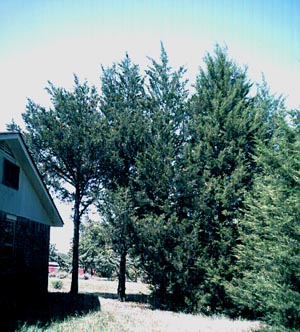 Harnessing
the wind has to become an obsession if one wants to keep their feet
planted on the ground in a prairie hill house. Customarily cedars are
planted on the north and the west side of the house. These cedars are on
the east and north but not across the front of the house. Why? Simply
because there is a beautiful view in front of the house and regardless
of the comfort of a wind break this view could not be sacrificed. The
other reason is that the septic tank laterals are on the front lawn.
This makes for a very nice verdant green lawn, but it is not wise to
plant trees over laterals with the possibility of having their roots
grow into the system. The reason for them being on the east is because
there was not room on the west side. The drive to the back of the acre
is there. The third reason is that it doesn't really hold true, north
and west winds prevail. Any protection or breaking of the summer hot
winds, or winter moaning gale is desirable. Harnessing
the wind has to become an obsession if one wants to keep their feet
planted on the ground in a prairie hill house. Customarily cedars are
planted on the north and the west side of the house. These cedars are on
the east and north but not across the front of the house. Why? Simply
because there is a beautiful view in front of the house and regardless
of the comfort of a wind break this view could not be sacrificed. The
other reason is that the septic tank laterals are on the front lawn.
This makes for a very nice verdant green lawn, but it is not wise to
plant trees over laterals with the possibility of having their roots
grow into the system. The reason for them being on the east is because
there was not room on the west side. The drive to the back of the acre
is there. The third reason is that it doesn't really hold true, north
and west winds prevail. Any protection or breaking of the summer hot
winds, or winter moaning gale is desirable.
My son and I dug these trees to bring
home when they were only two and three feet high. We dug them off the
road way. The mowing machines would get them sooner or later anyway. We
just beat the mowers to them. They were growing close to where there was
an abandoned old ranch home, spread out over the fence and onto the
highway right of way. The old ranchers really hated these wild cedars
because they could take a field, over growing it and causing a loss of
grazing for cattle. Once they were cut out, burned or jerked out with
tractors. Today, they are simply sprayed with a chemical which kills
them. There they stand.
This wild cedar is desired by the Native
American for use in their ceremonies. The cedar in small pieces can be
put in a grinding machine with water for an excellent disinfectant for
mopping floors. Winter wreaths to freshen the houses are nice and
probably were the original purposes of the yule cedar along with the
cedar yule log. These have a blue cedar berry some birds love. The
Native Americans gathered the cedar in the winter when it was strongest.
Their word for cedar is translated as, "green in the snow." It
was something akin to being a sacred plant.
These cedars act as a habitat for species
of birds. They are a place for rabbits to run to hide from neighborhood
dogs. There have even been pheasants to take refuge under them, and this
is a beautiful sight. So, they serve more purposes than just being a way
to "harness the wind." |

